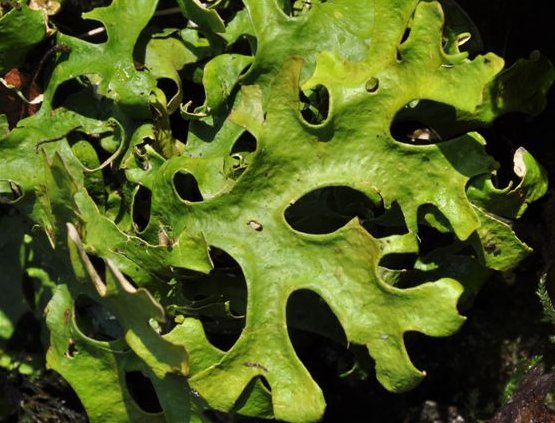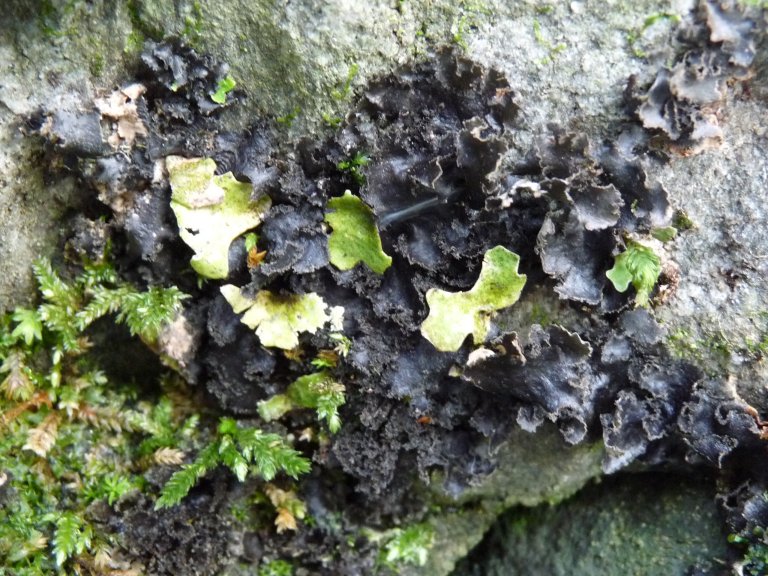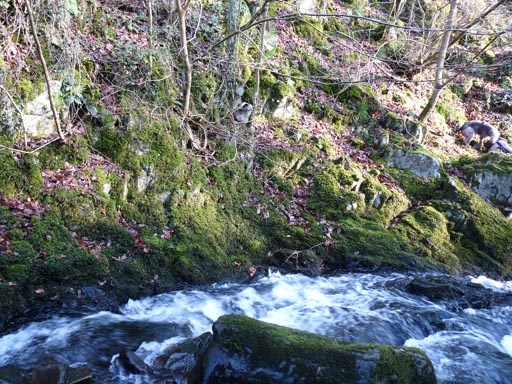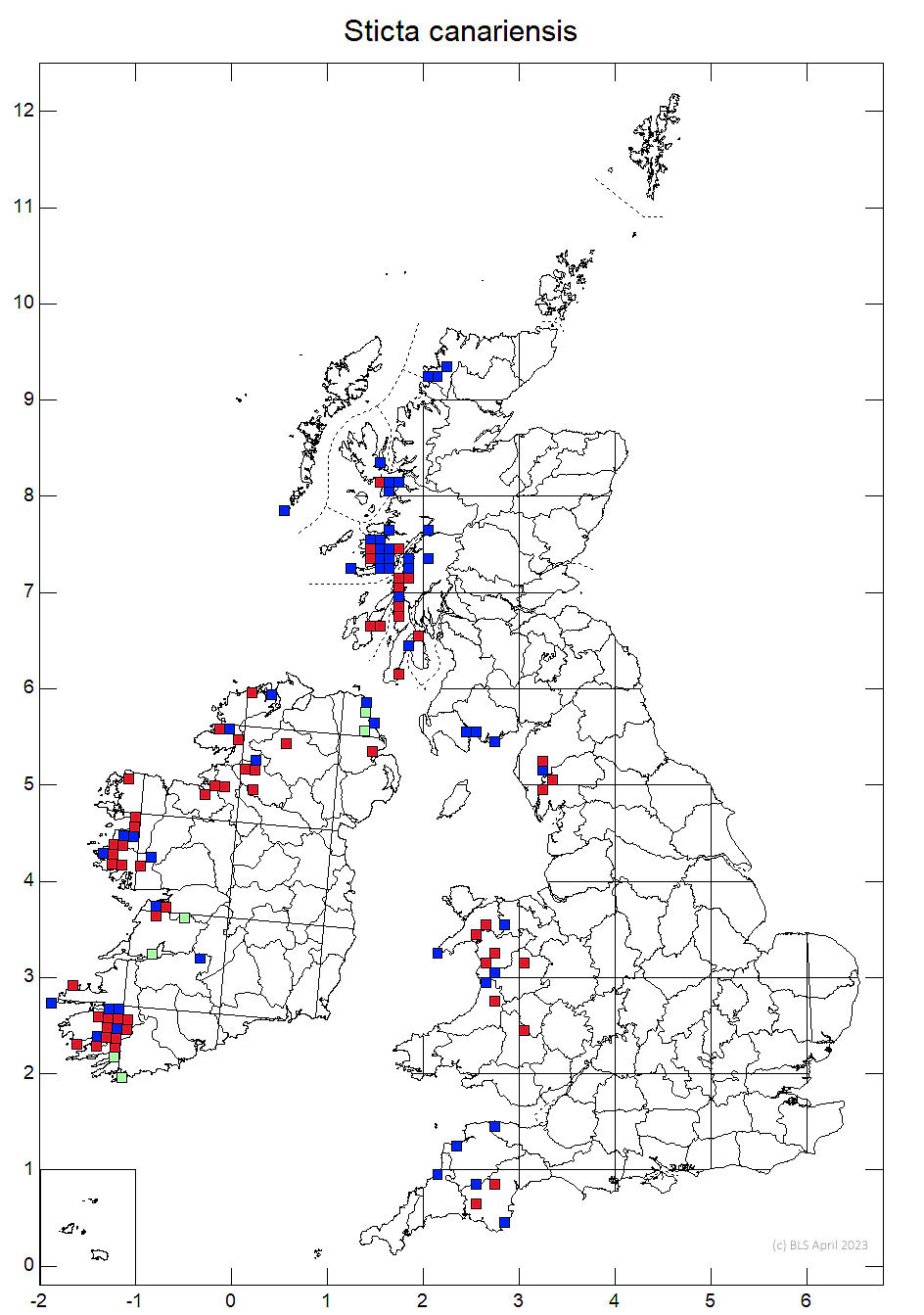Synonym for the cyanobacterial (=blue-green algal) morphotype is Sticta dufourii.
Whilst most lichen-forming fungi form an association with just one species of alga or cyanobacterium a few form a lichenised partnership with more than one. When one algal partner is a green alga and the other a cyanobacterium it is perhaps not surprising that the resultant lichens can look very different from one another. So great can be this difference that they have been given different scientific names.This unfortunately breaches the widely accepted convention that the name of a lichen is the name of its fungus since the fungi are considered to never be able to complete their life cycle without the algae or cyanobacteria whilst the algae and cyanobacteria are still capable of an entirely independent existence and so have their own names.
 |
 |
| Photo: Liz Fleming-Williams | Photo: Ray Woods |
Once it was established that the same fungus was involved with two different photosynthesising partners a decision had to be made as which of the two names should be used. The name Sticta dufourii had been applied for many years to the lichen with cyanobacteria as a photobiont and Sticta canariensis to the same fungus having a green alga as a photobiont. The latter name was adopted. So S. dufourii became S. canariensis cyanobacterial morph (or morphotype or photomorph) and S. canariensis became S. canariensis green algal morph (or morphotype or photomorph). The cyanobacterial morphotype is much more common in Britain and Wales than the green algal morphotype. Occasionally the green morph can be found growing out from the edges of the lobes of the cyanobacterial morph and very very rarely can the green algal morph be found growing on its own.
Section 42 lists only the green algal containing morphotype as being in need of special protection. Woods & Coppins (2003) specifically evaluate the green morph stage only when it is independent of the cyanobacterial morph. This independence is not specified in Sect 42. This is perhaps just as well as few records of the green morph specify whether they were free living or growing on the cyanobacterial morph. It is probable that in Wales the green algal morphotype only occurs growing at least initially on the edge of the thallus lobes of the cyanobacterial morphotype (see photo below).
In the one Welsh site subject to detailed scrutiny, over seventy colonies of the green morphotype occur on damp west-facing rock ledges mostly covered in the moss Thamnobryum alopecurum and high in the flood zone of a torrential river at relatively low altitude. Over the twenty odd years these colonies have been observed the Thamnobryum has expanded its range and has rather overgrown the cyanobacterial morph that supported the green alga morph. The green morph is however mostly able to outgrow the moss. On the few bare rock ledges the cyanobacterial morph occurs as small colonies, most of which have small lobes of the green morph growing from their edge. The rocks may be slightly basic as the woodland above is dominated by ash, hazel and wych elm. Most other sites appear to be sheltered ravines at relatively low altitude. (RGW)

Photo: R G Woods
It has proved remarkably difficult to pin down detailed information on localities for this lichen in Wales. This is perhaps just as well as it is probably very susceptible to over collection. For this reason exact details are withheld for one site at the request of the original recorders. If you legitimately need detailed information you should approach the recorders listed below. The British Lichen Society Atlas account 1365 (1998) maps its occurrence in 6 ten km squares. The SO04 record is known to be an error, this site supporting only the cyanobacterial morphotype. There are records from the Rheidol Valley, ravines beside the Dyfi and Mawddach Estuaries and from Fairy Glen near Betws y Coed. The record from the tip of the Lleyn is believed to be from Bardsey Island though an extensive search of the island over many years has failed to relocate it (Tony Fletcher pers. com.). It is possible that only the Mawddach population has been relocated in the last 30 years and this is the only population where some green morphs are known for certain to appear to be independent of the cyanobacterial morph.
The believed relatively small number and size of the few known populations renders this species susceptible to local catastrophic events such as rock falls, the collapse of overhanging trees and exceptional floods. The largest population is in the Snowdonia National Park but is not protected by a specific conservation designation. It lays amongst the remains of a metal mine, the reopening of which could without appropriate precautions threaten it.
Rose, F., (1998). Sticta canariensis green algal morphotype. Species account 1365/1998 in the third fascicle of the Lichen Atlas of the British Isles. British Lichen Society, London.
- Log in to post comments

